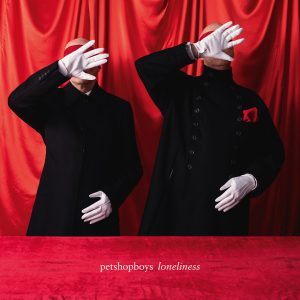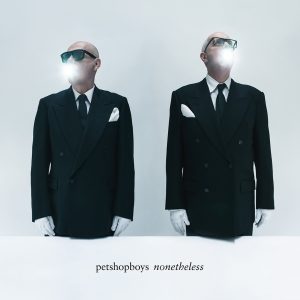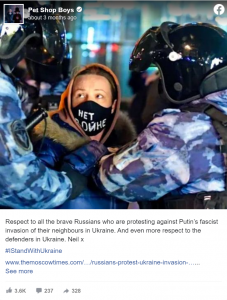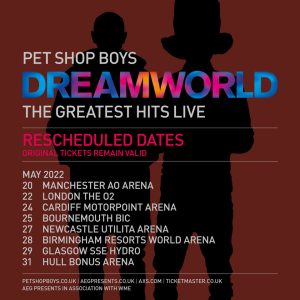The Pet Shop Boys have joined forces with Sadler’s Wells on The Most Incredible Thing, a ballet based on a Hans Christian Andersen fairy tale.
Neil Tennant hasn’t been sleeping well lately. ‘I’ll wake up in the middle of the night and think: What am I worried about?’ he says, while Chris Lowe, the other half of the Pet Shop Boys, chortles unsympathetically. ‘And then I remember: Oh yes! The ballet!’ As Tennant and Lowe enter their sixth decade as individuals and their fourth making music together, they might be forgiven for taking things a little easier. But that wouldn’t be interesting – and if you spend any time at all with the Pet Shop Boys, you’ll notice that ‘interesting’ is one of their favourite words.Which is why, apart from 10 extraordinarily consistent studio albums and their elaborate, theatrical live shows, they have taken on side projects from a West End musical to writing an orchestral score to the silent film classic Battleship Potemkin, which they first performed in Trafalgar Square in 2004 to a crowd of more than 20,000 people. Four years ago, they started work on what may be their most ambitious project yet: a three-act ballet that makes its debut in London next month. ‘What we wanted to do,’ Tennant explains, ‘was a narrative ballet with the sort of structure of a Tchaikovsky or Prokofiev ballet – Swan Lake is in three acts – but with contemporary dancing.’ Although the Oscar-nominated film Black Swan and the glut of dance-based reality shows on television are encouraging a new, wider audience to watch ballet, it is still rare to see lengthy new work. The Royal Ballet is launching Alice in Wonderland, a full-length piece choreographed by Christopher Wheeldon, at the end of the month, but this is a happy coincidence: no one I spoke to could remember the last time a new three-act ballet with an original score has premiered in London.With a 26-piece orchestra, video enhancements by the Israeli-born digital artist Tal Rosner and a spectacular set, the Pet Shop Boys’ ballet is a huge – and risky – production for Sadler’s Wells. ‘It’s one of the most ambitious things we’ve undertaken, both in terms of the length of the score and the design, which is quite remarkable,’ the theatre’s artistic director, Alistair Spalding, says. ‘It’s a gamble, both artistically and financially, but I feel we need to take those gambles. And the audiences are always very excited by that.’ It all started in 2007 with a phone call to Tennant from Ivan Putrov, then a principal dancer with the Royal Ballet. They had met through a mutual friend, the artist Sam Taylor-Wood, who collaborated with the Pet Shop Boys on the staging of their 1997 tour, and who has also worked with Putrov on various artworks. Putrov, who was born in Ukraine, had been offered a chance to perform at Sadler’s Wells during the Royal Ballet’s summer break, and wondered if the Pet Shop Boys would write some music for him. A few days later Lowe happened to mention that he was reading a new translation of the fairy tales of Hans Christian Andersen, and that one of the stories would make a great ballet. The Most Incredible Thing is short even by Andersen’s standards, running at only three pages. It concerns a king who decides to give his daughter and half his kingdom to the person who can come up with the most incredible thing, leading to an outbreak of feverish creative activity – and, of course, idiocy – worthy of a Simon Cowell talent show. The winner, however, makes something of real beauty: an extraordinary clock, built to show intricate scenarios as it strikes each of its 12 hours. But before he can marry the princess, another competitor smashes the work of art to pieces. This breathtaking act of destruction is, reluctantly, conceded to be an even more incredible thing, and the villain looks set to take the kingdom – until the clock’s broken figures come to life and kill him. It is a strange, dark tale, and you can see why it never became a children’s classic. But as a parable showing that ideas cannot be destroyed by brute force, it has real power – so much so, that copies of it were handed round during the Second World War as a rallying call to the Danish resistance movement. Once they began researching this history, Tennant and Lowe found the idea irresistible. ‘We love doing pop music, but how many people get to write music for a ballet and have it performed at Sadler’s Wells?’ Lowe says. When the Pet Shop Boys first started touring in the mid-1980s they were inspired by theatrical spectacles such as Grace Jones’s One-Man Show and David Bowie’s Diamond Dogs tour. Their first shows involved dancers and film backdrops by Derek Jarman, at a time when this kind of live stage show wasn’t the norm for a pop group. Since then they have continued to work with high-calibre collaborators from the architect Zaha Hadid to the opera directors David Alden and David Fielding. ‘There’s always been an interest in mixing music and some kind of theatre,’ Tennant says, and when their musical Closer to Heaven foundered after a relatively short West End run, in 2001, it made them even more determined to keep experimenting. ‘When it wasn’t a success, that gave me personally the hunger to continue to do something like this until we made it bloody work. Unlocking and unravelling this puzzle – a piece of theatre that has music as its heart and totally works – is really difficult. That’s the fascination.’ ‘They’ve got a good track record of working with very interesting and modern collaborators,’ says Emma Gladstone, the producer charged with putting a team together to create the ballet. Her department at Sadler’s Wells encourages collaborations between dance and other artforms. ‘I call it “cultural dating”,’ she says, adding that the final line-up for The Most Incredible Thing has turned out to be unusually collaborative, with many of the final ideas coming out of group discussions. One of her first calls was to Matthew Dunster, who in 2007 was a resident director at the Young Vic theatre, as well as a successful playwright. He took on the task of transforming a three-page story into a 20-page script that he subtitled ‘A Map for Music’. ‘I knew the Pet Shop Boys had done a very successful new score for Battleship Potemkin,’ he says. ‘So in a way, writing a silent film was our model. I gave them choices within each part of the story, to see which stimulated them the most. It was something they could follow, but which they didn’t necessarily have to stick to.’ Later, when the Venezuelan choreographer Javier de Frutos, and then Tal Rosner came on board, a longer draft was written, and the clock sequence expanded to include scenarios such as the Apollo moon landings. An artist with experience of setting images to live music – as well as winning a Bafta for his credit sequence for the Channel 4 series Skins – Rosner will create projections that play on a big screen throughout the performance. ‘I can ask Tal to do pretty much anything on that screen,’ Dunster says. ‘I’m used to having limitations as a theatre-maker, so it’s very exciting for me to feel I could write some sections of the piece without any limitations. If I wanted to go to the moon, then we could go to the moon.’ Over lunch at Sadler’s Wells the next day, de Frutos recalls when he first heard the Pet Shop Boys. It was in the mid-1980s, and he was working as a dancer in New York. ‘This was when people would stand in bars, watching MTV. And I remember this video came on, and there were lots of queens in the bar going, “Shhh. Listen to this! It’s really cool.” And it was West End Girls.’ Born in 1963 in Caracas to Argentine and Spanish parents, de Frutos describes himself as ‘a mongrel’, albeit one who has spent nearly half his life working in Britain. ‘I’ve been living here for almost 25 years now, so I’ve finally stopped bitching about the weather.’ It’s easy to see why he is a good creative fit with Tennant and Lowe. He has a mischievous sense of humour and a broad range of interests – his track record as a choreographer spans edgy contemporary dance, musicals such as Cabaret, a Turner Prize-nominated film short with the artist Issac Julien and a pop video with the singer Mika. In 2009 a dance piece called Eternal Damnation to Sancho and Sanchez caused a stir at Sadler’s Wells with its bloody orgy of stage violence. ‘I killed an imaginary Pope on stage, and some people got a bit upset,’ he says. ‘I got banned by the BBC and got three death threats.’ The new production will be less controversial. ‘My dancers are shocked: “You mean we’re not nude?” ’ He laughs uproariously, but Tennant and Lowe were clear from the start that this should be a family show. When they saw drawings for costumes for Adam and Eve, the first characters in the clock, which included pubic wigs, they immediately vetoed them. But it is not a show only for children, and like everyone involved, de Frutos appreciates the fact that the story can be read on many levels. A kingdom in recession; a king so desperate for solutions that he offers to give away his own child; the power of destruction. ‘We’ve all had experience of that in the last few years. All of us know where we were on September 11, we all remember the impact.’ When we meet, it is just over nine weeks before the run is due to start, but only the second day of the choreography, and de Frutos explains that it is all still at a fragile stage. He has spent two years researching Hans Christian Andersen, reading up on the Russian Constructivists (the starting point for the set design), listening to the demos of the music and thinking about the storyline. Now he has to leave his source texts and concentrate on expressing it all in movement. Today he is working with the two principal dancers, Clemmie Sveaas, 26, and Aaron Sillis, 27, who will play the princess and the clockmaker. (Ivan Putrov is playing the villain, Karl.) De Frutos has chosen to start in the middle of the story, when they meet and fall in love, to get the chemistry right between them. ‘You are creating the steps as you go along,’ he explains. ‘That’s why it takes longer than theatre, where you have the text already written. On the first day of a play, when everybody reads the script, you get a sense of, “Ah! This is where we’re going!” You don’t get that with dance. You create about 10 minutes of choreography a week. And we have nine weeks, so that’s cutting it quite fine. We also have the challenge of telling this story for the first time. If this ballet becomes a classic, and other companies take the music and want to do it all over again, then they will always compare it to the original.’ After lunch, we go through to the theatre. What I see in the following two hours is magical: the transformation of something quite tentative and mechanical between two dancers into a flowing, beautiful and very emotional encounter between a young couple falling in love. It starts with an unconvincing kiss and a lot of technical discussion – where an arm should go, how long a lift should be – but slowly it comes together as the dancers grow in confidence. The kiss is replaced with a far more tender touch of the cheek, and when they dance to a recording of the finished score, the scene is genuinely moving. After two hours of intense, sweaty work, they take a break. They have created just over a minute of movement. For Tennant and Lowe, the challenge was telling a story without words, giving each character a musical theme and interweaving these over longer melody lines than they would use in a pop song. ‘All the characters in the clock have their own different music, for instance,’ Tennant says, ‘and then when they’re killing the bad guy, all you can hear is shattered fragments of this music.’ Tennant’s voice appears only once in the show, when the princess is listening to a radio. ‘It’s completely different to a pop song, because you can’t rely on lyrics to tell the story,’ Lowe says. ‘You’re just trying to express it in music, to capture different emotions.’ We talk about the suppression of ideas, one of the themes of the ballet. The Pet Shop Boys have experienced this in its mildest form. When their most recent album, 2009’s Yes, came out in China, the government censor objected to a line on the closing track, Legacy: ‘Seasons will pass, governments fall.’ He asked for the line to be changed or muted, but Tennant and Lowe opted instead for the entire song to run as an instrumental. ‘They don’t like that!’ Lowe laughs. ‘Not in China: “Governments do not fall, get that out of your head right away!”’ Yes was their most pop-orientated album for some time, but its singles weren’t played on pop radio stations, something that still annoys Tennant. ‘I can’t relax about that,’ he says. ‘Well, you’re going to have to,’ Lowe shrugs. ‘I think one of the issues is that pop music is not meant to be made by older people. But I’ve never understood this idea that at some point you’re supposed to stop liking what you did. I still like going to some dubstep club in Shoreditch.’ None the less, the Pet Shop Boys have never pretended to be younger than their years (Tennant is 56, Lowe 51). ‘We’re not selling sex. And we never have,’ Tennant says. ‘Speak for yourself,’ Lowe says indignantly, before hooting with laughter. At times, interviewing the Pet Shop Boys can be like watching an experienced double act going through its routines: it all works because they complement each other perfectly. ‘Their creativity seems to be brilliantly split down the middle, which is probably why they’ve lasted as long as they have,’ Dunster observes. ‘Neil is very much the frontman, he’ll do the majority of the talking. And Chris sits at the back and doesn’t say very much. But when he does, it’s always the thing that gets us back on track. It’s no surprise that it was Chris who found the story for the ballet.’ In more than 30 years of working together there have been strains – especially on tour – but they have never really fallen out. ‘It’s a shame, really, because you don’t get the “Robbie rejoins Take That” moment,’ Lowe says. ‘Staying together is not as good a story.’ There is perhaps less glory in keeping on without too much drama, in consistently making art with a certain integrity. But the Pet Shop Boys have done this, and in recent years have been recognised for it as increasing numbers of younger artists cite them as a key influence. Starting with a Brit award for Outstanding Contribution to Music in 2009 and peaking with a triumphant headlining slot at last year’s Glastonbury Festival, they might now be considered national treasures. Which means, for them, more opportunities to do new and interesting things. Last year, for instance, they wrote the music for the Young Vic’s Christmas show, My Dad’s a Birdman, a touching play by the children’s author David Almond. ‘We’ve never at any point had a masterplan,’ Tennant says. ‘We just want to keep on doing fantastic projects – and hopefully make really good records. It’s an all-consuming thing, really. It takes up a vast amount of our lives. But ultimately, that’s what fuels us, what keeps us going.’
Taken from: The Telegraph
Interviewer: Sheryl Garratt





